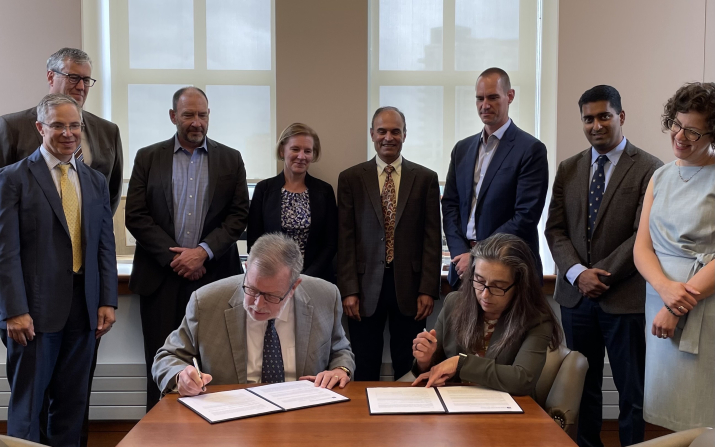Case Western Reserve University, Lawrence Livermore National Laboratory agree to collaboration

The leaders of Case Western Reserve University and Lawrence Livermore National Laboratory (LLNL) signed an agreement yesterday to accelerate their efforts in shared areas of excellence.
After three years of steadily growing institutional collaboration in such areas as energy, materials science and polymer processing, Case Western Reserve President Eric W. Kaler welcomed Livermore Director Kim Budil to the university’s campus.
“Both of our teams have embraced opportunities to partner with enormous enthusiasm and ingenuity,” President Kaler said. “We are grateful to Congresswoman Marcy Kaptur for helping to catalyze this connection, and very much look forward to building on our strong progress to date.”
Located less than an hour’s drive from San Francisco, the Livermore Lab is one of 17 laboratories around the country operating under the auspices of the U.S. Department of Energy. Their mission is “to push the boundaries of science, engineering and technology” to advance aspects of the energy department’s mission.
“We’re pleased to continue our successful collaboration with Case Western Reserve,” said LLNL Director Kim Budil. “This agreement provides an important framework as we partner to advance some of today’s most transformative science and technology.”
In the document signed Tuesday, the two institutions agreed to:
- Exchange and share science and technology ideas;
- Enable student opportunities and internships; and
- Pursue research activities in areas of joint interest and benefit.
Conversations to collaboration
The two organizations began discussions 2019 at the suggestion of U.S. Rep. Kaptur (D-Ohio) and then National Nuclear Security Administration leader Lisa Gordon-Hagerty, said Grant Goodrich, executive director of the university’s Great Lakes Energy Institute.
Case Western Reserve and LLNL officials said the university and lab have benefitted over the last several years as their relationship has grown. LLNL has provided funding and expertise to advance research at the university, and CWRU provided a talent pipeline to LLNL, beginning with five internships over the last few years and the hiring of an employee in 2020.
CWRU and LLNL representatives also visited their counterpart’s campus or held virtual meetings nearly a dozen times over the last several years, including for technical presentations and seminars.
Among the other highlights:
LLNL awarded four research grants totaling more than $2 million to CWRU faculty since 2020 from its research and development arm. It funded or collaborated on research being conducted by Dustin Tyler, the Kent H. Smith II Professor of Biomedical Engineering; Rohan Akolkar, the Milton and Tamar Maltz Professor of Energy Innovation and the Ohio Eminent Scholar in Advance Energy Research at the Case School of Engineering; Matthew Willard, professor of materials science and engineering; and Laura Bruckman, associate professor of materials science and engineering.
The lab awarded a $1.1 million grant to a broad-based team led by Roger French, the Kyocera Professor in the Department of Materials Science and Engineering at the Case School of Engineering and a team of researchers to investigate material degradation and lifetime extension of advanced materials. The lab is also a member of the National Science Foundation-funded Materials Data Science for Reliability Center at CWRU, a joint project with the University of Pittsburgh—also led by French.
Shared research projects among Akolkar and LLNL researcher Scott McCall; and João Maia, a professor of macromolecular science and engineering and director of the Center for Advanced Polymer Processing and LLNL researcher Fei Zhou.
For more information, contact Mike Scott at mike.scott@case.edu.
This article was originally published Aug. 9, 2022, in The Daily.
